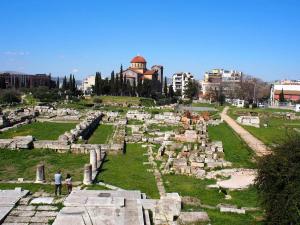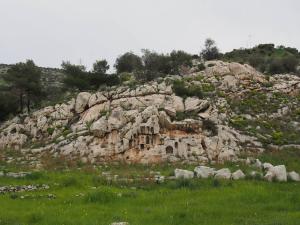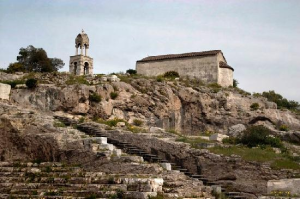Eleusinian Mysteries
In this post, I would like to share a part of our class experience since my friends and I are doing our postgraduate degree near such important and interesting heritage sites which still have a cultural and historical value for the local people, not only archaeologists and heritage managers.
Elefsina (Eleusis), where the current MA’s lectures are taking place, is famous to historians and archaeologists for its sanctuary to Demeter and its associated cult which is one of the most famous religious observances in Ancient Greece. The details of the cult are still unknown due to its high secrecy. It had been practiced for over 2100 years from 1700 BC and the 20 kilometer pilgrimage route starting from the center of Athens to Elefsina was trekked by foot. This practice continued through generation to generation, but was abandoned after a prohibition order of pagan activities by the Christian Roman Emperor Theodosius I in the fourth century A.D.
However the road taken by those palmers, called this the Sacred Way (Iera Odos), can still be observed today in its tangible form and intangible values. Figure 1 shows an estimation of the way by archaeologists and historians.
The whole journey starts from, the Eleusinian at the Acropolis (pink point), and pass a gate of Athenian walls at Kerameikos (yellow point). Then it follows along the modern day highway still called “Iera Odos” which passes by the Sanctuary to Aphrodite (blue point). Finally it arrives in Elefsina (green point), where the religious cult activity was talking place.
The students participated in a field trip that traced the ruins of the Sacred Way, visiting Aphrodite’s Sanctuary as well as stretches of the stone path that created the Way which have been uncovered.
Eleusinian near the Acropolis
The Eleusinian was used as storage for all the sacred objects of the Eleusinian Mysteries during its ceremonies, which is located near the Acropolis in Athens. The participants started their pilgrimage journey from here.

Fig2: A part of the Acropolis. Photo Credit: Yoshitaka Sasaki
Kerameikos
The name, Kerameikos, came from the word “pottery”, in Greek since potters and their painters used to settle around this area (Ministry of Culture and Sports in Greece, 2012). As Figure 3 shows, it is currently an archaeological site, and a gate of the Athenian wall was located here as a Figure 4 shows due to the protection of the city in ancient times. It was also place to bury the soldiers killed by battles (Ancient Athens 3D).

Fig3. Kerameikos. Photo Credit: Yoshitaka Sasaki

Fig4: 3D images of ancient Kerameikos. Photo Credit: Ancient Athens 3D
The road is divided into two ways; the Iera Odos being to the right. The road is still actively used and is one of the main roads to go Elefsina from Athens today.

Fig5: A crossroad. Photo Credit: Yoshitaka Sasaki
Aphrodite’s Sanctuary
According to one of our professor’s, the sanctuary, located at the middle point between Athens and Elefsina, is dedicated to Aphrodite, the goddess of love, beauty and fertility. Those rock cut niches in Figure 7, were created by pilgrims and initiates to the cult to house votive offerings to help solve problems in their personal lives in relation to characteristics of Aphrodite. It is currently surrounded by fences, but is still religiously popular among the locals as a Figure 8 suggests. This offering was there when our class arrived at the site, making it highly possible that this offering was made within few days of our visit. In this sense, the Sanctuary has both tangible and intangible value for the locals.

Fig6: The cave and its fence. Photo Credit: Yoshitaka Sasaki

Fig7: Rock cut niches for votives to Aphrodite. Photo Credit: Yoshitaka Sasaki

Fig8: An offering. Photo Credit: Yoshitaka Sasaki
Remains of the Way
Near the Sanctuary, there are remains of the Sacred Way in Figures 9 and 10. The stones of the passage are originals, so the passage has enormous level of authenticity. However, there are no informational signs or explanations to show this important site, and unfortunately a water park for children was built in front of this passage ruining the site’s authenticity. It is almost impossible to distinguish those stones in front of the amusement park which have existed there from ancient times. This type of controversial problem is also a case of concern by the field of Heritage Management.

Fig 9: The Sacred Way runs along a modern water park. Photo Credit: Yoshitaka Sasaki

Fig10: Remains of the Sacred Way. Photo Credit: Yoshitaka Sasaki
Elefsina (Eleusis)

Fig11: Elefsina Archaeological site. Photo Credit: Trip Advisor
Then the 20km journey ends at another acropolis, currently known as the Archaeological Site of Elefsina. It is a site that is mythologically known as the city where Hades had taken Demeter’s daughter Persephone down to the underworld. The myth has it that when her daughter was taken, Demeter was so upset that she allowed all the crops in the world to die. A deal was made with Hades that Persephone would be allowed to come up to Earth to be with her mother for 6 months out of the year and spend the rest of the year with him in the underworld, and this is why we have the seasons. The essence of the cult was to ensure that the harvest would happen year after year. Initiates of the cult would make their way through the site and up the hillside to the largest covered temple known as the Telesterion where the secret rituals of the cult were performed.
This Sacred Way is a great case study for heritage managers as the values of these sites do not enhance or provide their importance to the present population due to its poor or lack of management. We need to establish ways to overcome the issue effectively and efficiently, which is what my classmates and I are training to do.
References
- Ancient Athens 3D, (n.d.). Kerameikos, [Online]. Available from: http://www.ancientathens3d.com/kerameikosEn.htm [29 March 2014].
- GREECE.com, (n.d.). RHEITOI (LAKE KOUMOUNDOUROU) [Online]. Available from: http://www.greece.com/photos/destinations/Attica/Athens/Lake/Koumoundourou_Lake/Rheitoi_(Lake_Koumoundourou)/41562505 [29 March 2014].
- Official web-site of the city of Eleusina, History of Elefsina. Available from: <http://www.eleusina.gr/history/syntomo_istoriko.aspx?sflang=en>.[18 March 2014].
- Ministry of Culture and Sports in Greece. (2012), Kerameikos. [Online]. Available from: http://odysseus.culture.gr/h/3/eh351.jsp?obj_id=2392 [29 March 2014].
- Elefsina Archaeological site (n.d) Tripadvisor [Online] At http://media-cdn.tripadvisor.com/media/photo-s/01/56/71/a6/archaeological-site-elefsina.jpg
Yoshitaka Sasaki is a postgraduate student in the MA in Heritage Management 2013-2014. He mainly took business administration studies with philosophy and social science courses within a liberal art degree during his undergraduate. Yoshitaka’s main interest is to find ways of managing heritage sites by enhancing the values of sites in understandable forms to visitors and related stakeholders in the context of the tourism industry, aided by his study abroad experiences in Switzerland, Thailand and Greece.


